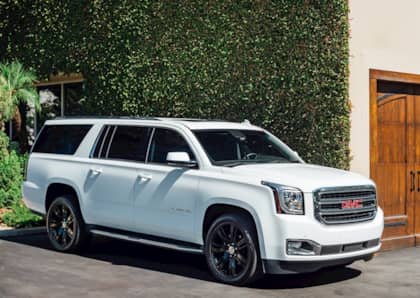Are The GMC Syclone And Typhoon Poised To Become High-End Collectibles?
Once upon a time, General Motors decided to build the fastest pickup in the world. It was the late 1980s, and the trigger for the truck came from the least-likely source: Buick, which had built a test rig that borrowed the bones of Chevrolet's compact S-10 and re-animated them via a 3.8-liter turbocharged V6 lifted from the vaunted Grand National production line.
It was an intriguing idea. Buick was about to lose the G-body platform that had given it so much performance cachet with the Regal-based GNX, and the front-wheel drive replacement for the car wasn't exactly up to snuff in the go-fast department. Still, the head honchos at the RenCen weren't keen on the idea of Buick suddenly getting into the pickup game. The concept was offered to Chevrolet, which passed because it had its own muscle truck in the mix—the 454 SS—and didn't want to steal its thunder.

That left GMC, often the odd one out of the performance conversation at General Motors, which was all too willing to see where a compact screamer might take them. While the GNX-sourced drivetrain was already a wild take for a segment more used to workaday four-bangers and torque-oriented V6s, it was nothing compared to what would actually hit the streets in production form.
The GMC Syclone was a jaw-dropper when it arrived in 1991, and it's still a potent package today—if you can find one, that is.
Absurd Performance
GMC's bigwigs were all-in on the idea of a turbocharged pickup, but they had some engineering notes before the vehicle made the leap from concept to showroom. The first was the decision to swap out the 3.8-liter mill for the more modern 4.3-liter V6 that was offered in the existing (and recently refreshed) GMC Sonoma. Matching with a Mitsubishi TD06-17G turbocharger, the unit was massaged with a L98 throttle body (borrowed from the Corvette), a Garrett intercooler, and a set of boost-friendly bespoke internals.

All in all, the 4.3 would produce a whopping 280 hp and 350 lb-ft of torque, which were multiples of what the standard Sonoma had to offer. Faced with the realities of unleashing this much grunt on the lightweight rear end of an unloaded pickup, GMC also elected to install a Borg-Warner transfer case that split output 35/65 front-to-rear, matched with a four-speed automatic transmission.
The inclusion of AWD was a game-changer for the Syclone. Suddenly, here was a lightweight, over-muscled truck that could put all of its power down with nary a concern for traction. The numbers reflected just how much of a concern GMC's little monster presented to the established sports car hegemony, what with 60-mph arriving in a scant 4.3 seconds, and the quarter mile disappearing in an unbelievably quick 13.4 seconds @ 98 mph.
Just a few ticks over four seconds is still a very fast 60-mph sprint today. In 1991, it was absolutely ridiculous. Not only was the GMC Syclone the fastest vehicle in the entire General Motors portfolio, it was also capable of shaming contemporary Porsches, Ferraris, and pretty much anything wearing a license plate.
Too Fast For Love
Unfortunately, the public was somehow indifferent to the Syclone's ample charms, perhaps turned off by its $25k price tag (still tens of thousands cheaper than anything with comparable quickness), and its inability to actually do pickup truck stuff like tow and haul, due to concerns from GM about its lowered suspension system and trailer-related liability. A mere 2,995 versions of the vehicle (all in black, with the exception of a handful of Marlboro-livered, targa-roof specials) were sold in its single model year of production.

Undaunted, GMC's engineers turned their attention to a compact Jimmy sport-utility, which shared its frame with the Sonoma and offered an extra dose of practicality compared to the single-cab pickup. The Syclone's mechanicals were transplanted nearly lock, stock, and barrel into the SUV (save for an upgrade transfer case), and the ensuing model was named the Typhoon (with a few extra paint colors added to the mix).

Although the extra weight of the Jimmy platform would add nearly a second to the vehicle's 0-60 sprint, it was still extremely fast for its time. Unfortunately, customers weren't any more receptive to the Typhoon than they were the Syclone, with a mere 4,697 being sold for the 1992 and 1993 model years. Shortly thereafter, the idea of a turbocharged trucklet was retired forever by the General.
Approaching Unobtainable Status
It's a safe bet that GMC will never again be able to claim the worldwide performance crown, let alone do it with a reasonably affordable pickup truck. For those seeking past glory, the time is now to snag a Syclone or trap a Typhoon, because the pricing trajectory for these trucks seems destined to continue its upward momentum.

Top-dollar for the Syclone currently sits around $60,000 for a no-flaws example, and while the Typhoon trails it, the differential isn't all that great. Taking into account the scarcity of these vehicles - roughly 7,500 altogether, with the Syclone only making up 25% of that figure - the number of survivors over the past 30 years in the kind of condition one would want to collect is diminishingly small.
We're not yet at the point where these vehicles are being bought and stashed as static display items in high-end collections, but that time is approaching. If you want to drive one of the fastest trucks ever built , and specifically one that will actually fit inside your garage rather than be exiled to the driveway in front of it, your window on snagging a SyTy deal is on the verge of closing.
The next smaller-than-full-size performance pickup traded turbos for a V8. Learn more about the Dodge Dakota R/T.











